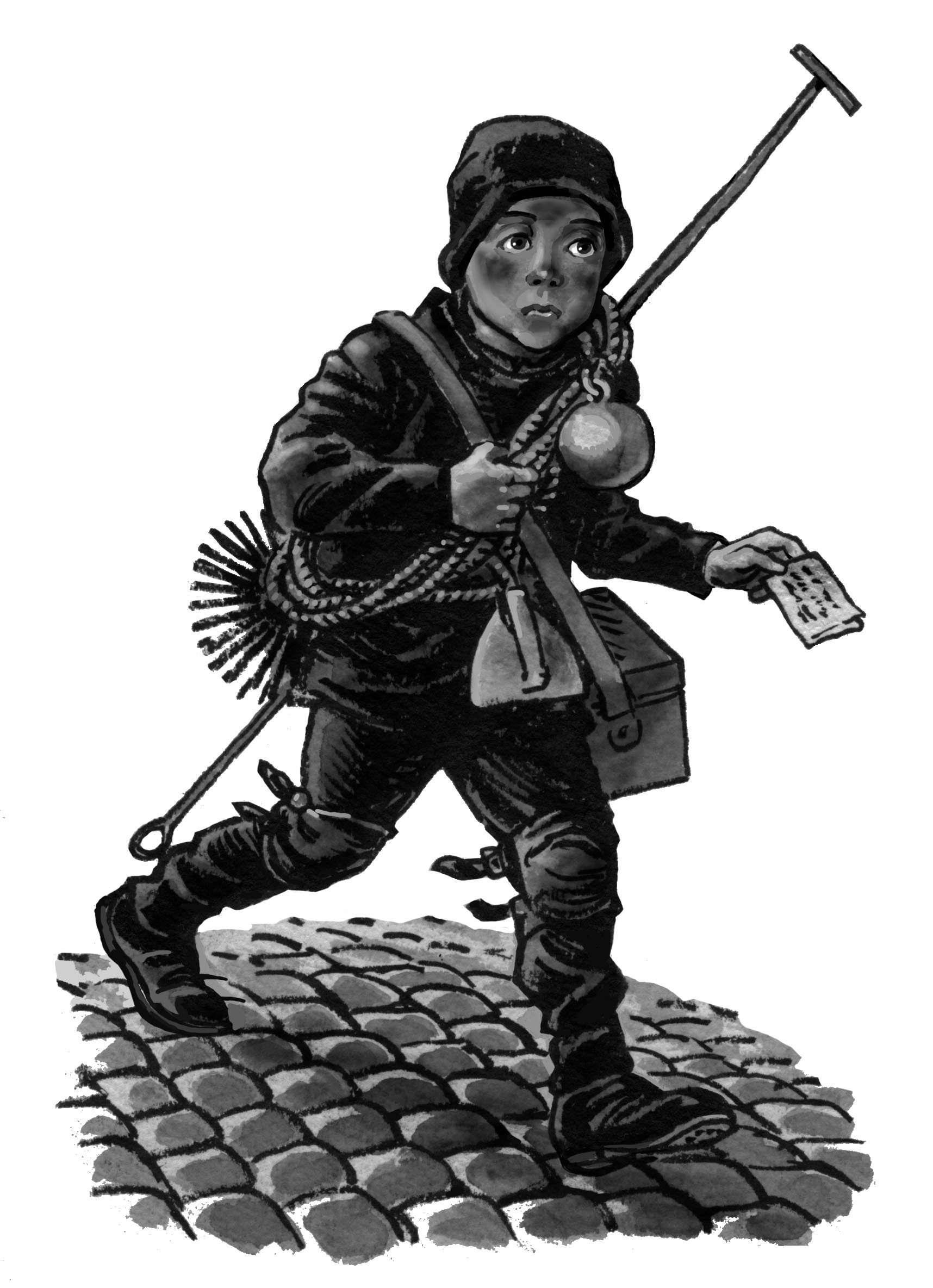Chimney Sweep
Cliquez ici pour la version française
Le Ramoneur | The Chimney Sweep
Little chimney sweep from Savoie (“Petit ramoneur savoyard”, 2008 drawing by Wikimedia Commons contributor Morburre)
A ramoneur, or chimney sweep, is a person who removes the ash and soot from chimneys. With regular use, a chimney’s walls accumulate soot, a mass of carbon particles, which restricts the flow of air and is highly flammable. A chimney sweep’s job is to remove the soot, allowing the chimney to function properly and prevent fires.
Under the French regime, homes had large hearths for cooking and heating. Because of their size, a small man could fit in the chimney, normally entering from the bottom, climbing to the top and cleaning the soot from the walls as he clung on and slowly descended. He used a small scraper and a broom affixed with twigs, but mostly his bare hands and his clothing. The sweeper usually worked barefoot, allowing him to more easily find footholds along the chimney walls. He was instantly recognizable in town, as he always wore a tight-fitting toque, kneepads and a type of leather protector for his bottom. On his belt were two iron rings where a rope could be looped through. A co-worker would hold the end of the rope and stand on the roof, preventing the chimney sweep from falling. He would lower the sweeper slowly down the chimney, holding onto knots that were tied every foot along the rope. Once he was finished, the sweeper was completely black from soot from head to foot, with only his eyes and teeth displaying white.
Chimney sweep of Strasbourg (“Ramoneur de Strasbourg”, 1870 drawing by Wencker and Touchemolin, Gallica.bnf.fr, Bibliothèque nationale et universitaire de Strasbourg).
Nicknamed “Monsieur Suie” (Mr. Soot), his occupation was also nicknamed savoyard, as most chimney sweeps in Québec and Montréal came from the Savoie region of France. The Intendants of New France even sent written requests to the Savoie, asking for chimney sweeps to be sent over.
One couldn’t simply become a chimney sweep—you either had to have practiced the occupation in France, or in Québec as a master’s apprentice. Since the primary prerequisite to be a chimney sweep was to be small, most sweepers started at age 13 or 14.
Under the English regime, chimney sweeps started using weights and scrappers to clean chimneys. Regardless of the method, having your chimney swept was very intrusive for inhabitants. They had to stop using the hearth two days prior to the sweeper’s arrival, which meant that they couldn’t cook during this time. It also caused a giant mess. The floors got covered in soot, and all furniture and objects had to be covered up.
At the beginning of the 18th century, stoves started to replace hearths, and new chimneys were much smaller. Sweepers started to use a new technique involving a fir tree and a rope tied to each extremity. One sweeper stood on the roof, while the other stood at the other opening and, using an upside-down fir, they each pulled on the rope in turns, cleaning the inside of the chimney. One downside to this technique was that many trees were required per day.
Chimney sweep (“Ramoneur”, 1890 engraving by Henri Guérard, Gallica.bnf.fr, Bibliothèque nationale de France).
Chimney Sweep (“Sotare”, 1880 oil painting by Frans Wilhelm Odelmark, Wikimedia Commons).
1910 postcard of a savoyard, digitized by Wikimedia Commons author Siren-Com
Chimney sweeps were considered an important part of society, especially when it came to fire prevention. On 27 Jan 1711, an ordinance was published in Montreal, stating that all bourgeois merchants and inhabitants of the city had to have their chimneys swept every two months. If anyone refused the order, they would be fined 3 livres. The ordinance also required that sweepers be paid 10 sols per chimney in cash. In cases where there were two chimneys one above the other, or three or four pipes, the first would cost 15 sols and the following 10 sols.
Despite this ordinance, fire was still an ever-present danger due to the closeness of houses, and the fact that most were built of wood. In June of 1721, an enormous fire destroyed nearly half the city of Montreal. In the aftermath of this disaster, new building regulations were passed. Houses had to be constructed of stone going forward, be at least 2 stories high, have firewalls and slate roofs with ladders for chimney sweeping. Between the years 1676 and 1759, no less than 16 ordinances were passed relating to chimney sweeping.
Out in the countryside, homeowners generally took care of chimney sweeping themselves.
Have you ever visited the old parts of Québec City and Montréal and noticed ladders affixed to rooftops? These were once used by chimney sweeps. Today, they are used for snow removal in winter.
Can you spot all 8 ladders? (copyright-protected photo by The French-Canadian Genealogist)
Fun fact: during the 19th century on Mardi Gras, children used to disguise themselves as chimney sweeps, spreading soot all over their faces and going door-to-door collecting candy (similar to today’s Halloween).
Known persons that had this occupation: Nicolas Dufaye dit Lamarche, Claude Duval dit Vinaigre, Emmanuel Gareu dit l'Espagnol, Pierre Gatien, François Héritier dit Lamalice, François Perrault, Pierre Queureté, François Rolet, François Savary.
Sources:
Jeanne Pomerleau, Métiers ambulants d'autrefois (Montréal, Québec: Guérin, 1990), 285-296.
Pascale Girard, "Les métiers en Nouvelle-France", Semaine nationale de la Généalogie (2014); online article, Fédération québécoise des sociétés de généalogie (http://www.semainegenealogie.com/extra/articles/182-les-metiers-en-nouvelle-france).





